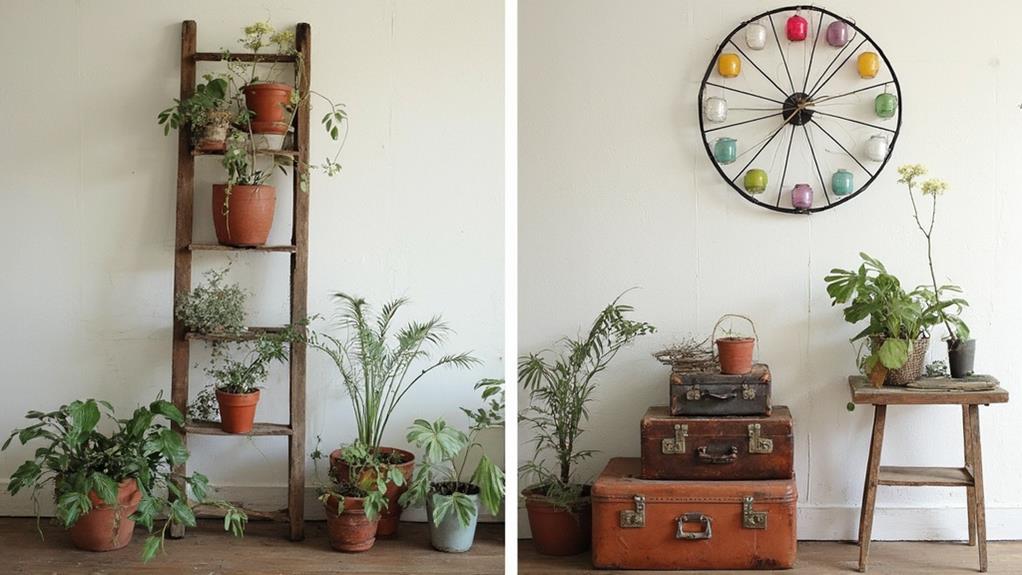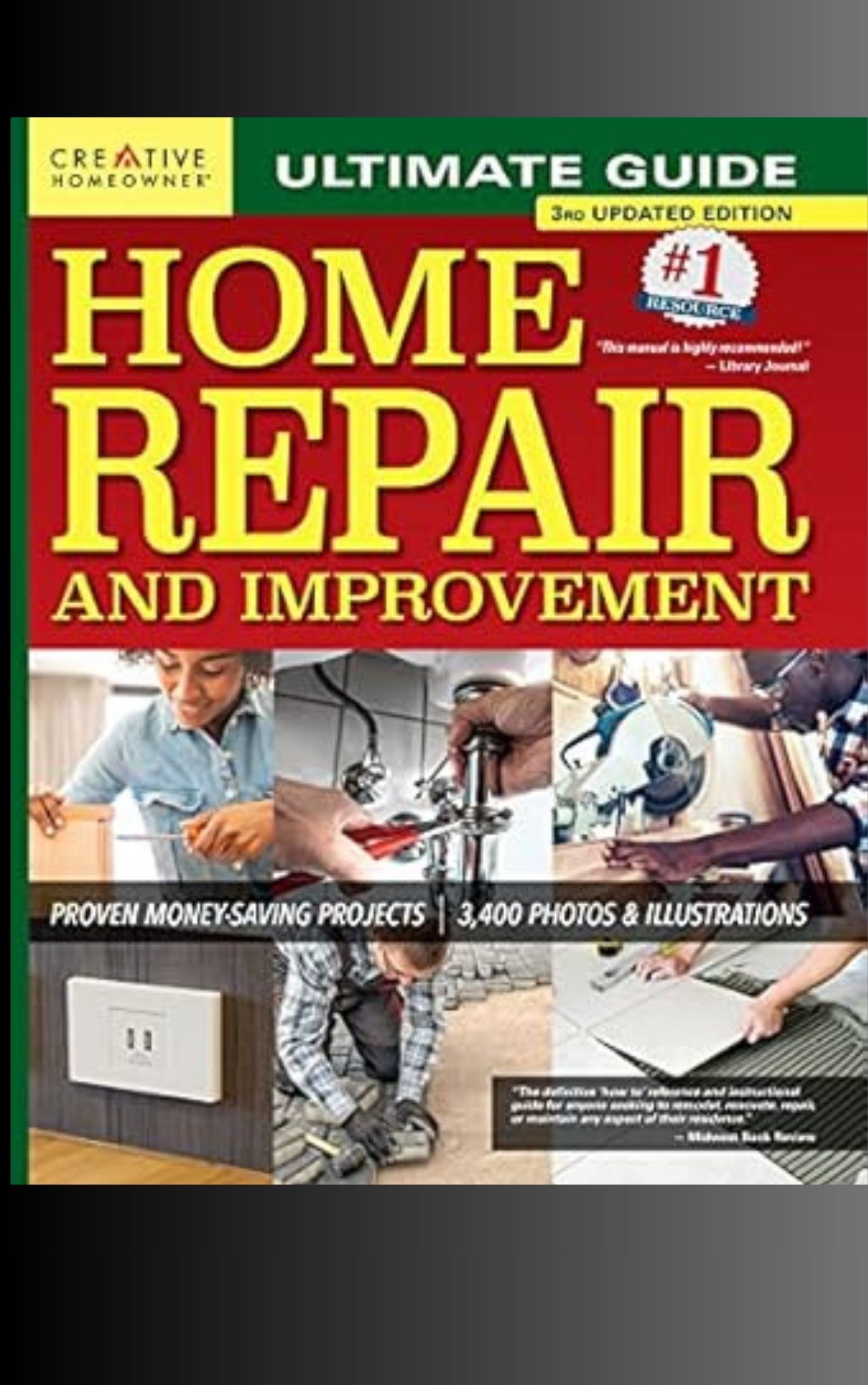Repurposing everyday items for home decor offers a creative and budget-friendly way to personalize living spaces. Mason jars can become charming light fixtures or organizers. Ladders transform into unique bookcases or towel racks. Wooden crates serve as modular shelving or rustic coffee tables. Vintage suitcases double as stylish storage solutions. Upcycled lighting options range from wine bottle lamps to repurposed kitchen utensil chandeliers. Old books find new life as sculptures or hidden storage. Pallets offer versatility for furniture and wall art. These innovative ideas not only save money but also reduce waste, adding character and sustainability to your home. Explore further to uncover more inspiring upcycling possibilities.
Mason Jar Magic
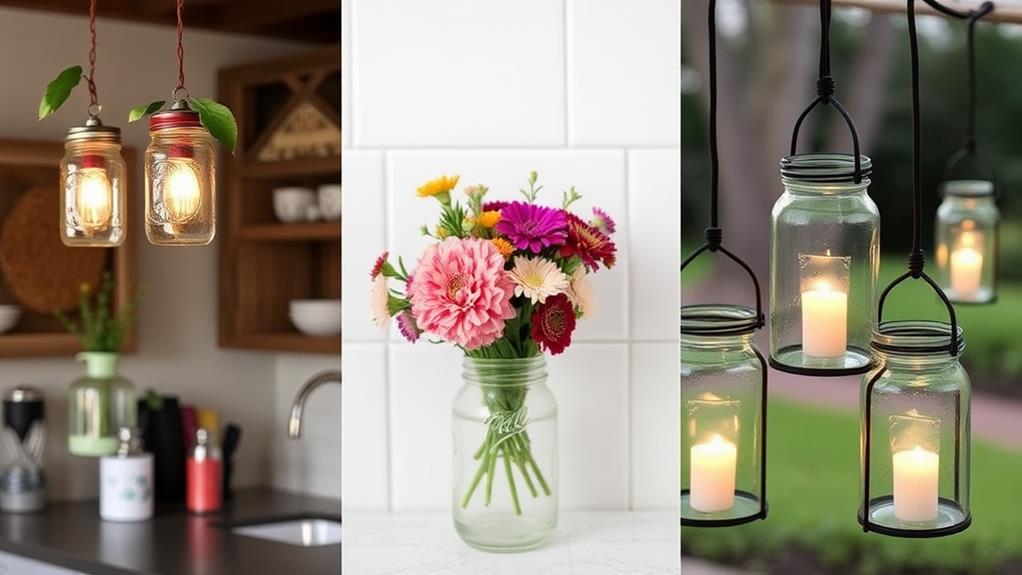
Mason jars have become a versatile cornerstone in home decor, offering endless possibilities for creative repurposing. These humble glass containers can be transformed into charming light fixtures, rustic vases, or practical storage solutions. By adding a metal lid with a hole and inserting a lamp kit, mason jars become unique pendant lights or table lamps, casting a warm, inviting glow.
For a softer ambiance, fill them with fairy lights or candles to create enchanting centerpieces or outdoor lighting.
In the bathroom, mason jars make excellent organizers for toiletries, cotton swabs, and makeup brushes. In the kitchen, they can be mounted under cabinets or on walls to store spices, utensils, or dry goods. Painted or decorated mason jars add a pop of color to any room as flower vases or pencil holders.
For a functional twist, attach them to wooden boards to create wall-mounted planters or organize office supplies. By thinking outside the box, mason jars can be used to craft soap dispensers, wind chimes, or even bird feeders, proving that these versatile containers have a place in every room of the house.
Ladder Love
Repurposed with creativity, old ladders have climbed their way into the world of interior design as versatile and eye-catching decor elements. These functional pieces can be transformed into unique storage solutions, display units, or standalone decorative features.
In living rooms, wooden ladders can serve as unconventional bookcases, with each rung holding a selection of favorite reads or cherished mementos. For bathrooms, ladders offer a rustic alternative to traditional towel racks, adding a touch of charm while maximizing vertical space.
In bedrooms, ladders can be repurposed as clothing organizers, perfect for hanging scarves, belts, or jewelry. Painted in vibrant hues or left in their natural state, they can complement various design styles from farmhouse to industrial chic.
For outdoor spaces, ladders make excellent plant stands, allowing you to create a vertical garden on a patio or balcony. When positioned against a wall, they can showcase trailing vines or potted herbs. Creative homeowners have even repurposed ladders as overhead lighting fixtures, suspending bulbs or mason jars from the rungs to create a striking focal point in any room.
Crate Creations
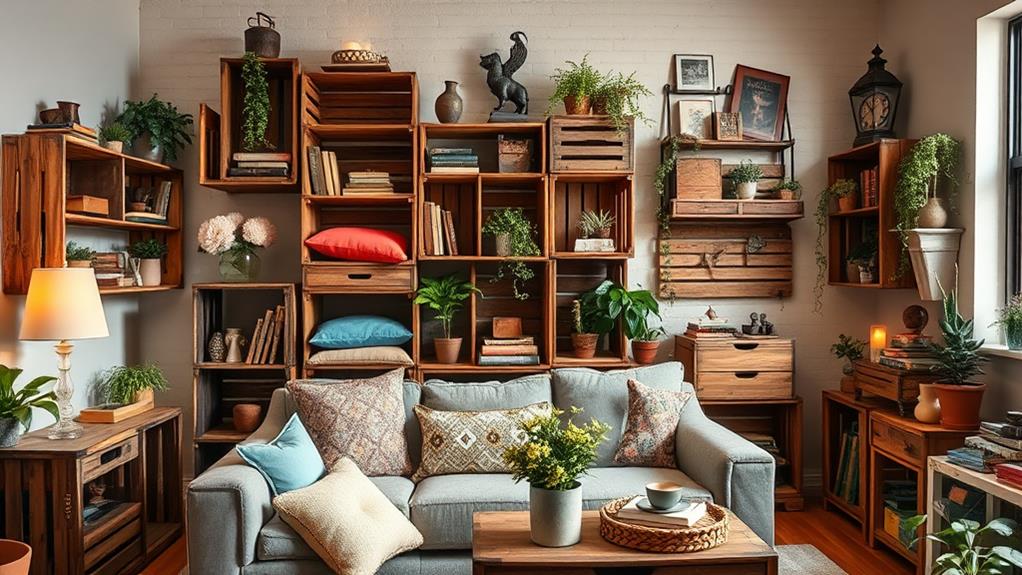
Wooden crates, once relegated to storage and transportation, have emerged as a versatile element in home decor. These rustic containers offer a myriad of possibilities for creative repurposing, adding both functionality and aesthetic appeal to various living spaces.
One popular application is using crates as modular shelving units. Stacked horizontally or vertically, they create customizable storage solutions for books, plants, or decorative items. When mounted on walls, crates serve as unique display cases or floating shelves, perfect for showcasing collectibles or family photos.
In the bedroom, crates can be transformed into stylish nightstands or underbed storage units. For living areas, a cluster of crates can form an innovative coffee table, complete with built-in compartments for magazines and remote controls. In home offices, crates make excellent organizers for files, supplies, and electronics.
Crates also shine in outdoor spaces. Painted or stained, they can become charming planters for herbs or flowers. When fitted with cushions, crates double as rustic seating options for patios or garden nooks. Their versatility extends to entryways, where they can be repurposed as shoe racks or umbrella stands.
Suitcase Storage Solutions
Vintage suitcases, with their nostalgic charm and sturdy construction, offer innovative storage solutions for the modern home. These timeless pieces can be repurposed in various ways to add both functionality and style to any room.
Stack different-sized suitcases to create a unique side table or nightstand, providing hidden storage within each case. Wall-mounted suitcases serve as eye-catching shelving units, perfect for displaying books, plants, or collectibles.
For a practical approach, use suitcases as under-bed storage containers, ideal for keeping out-of-season clothing or extra linens organized and dust-free. In the living room, a large suitcase can double as a coffee table with built-in storage for magazines, remote controls, and other small items.
Smaller suitcases make excellent organizers for craft supplies, sewing materials, or office essentials. In children's rooms, suitcases can store toys or dress-up clothes while adding a whimsical touch to the decor. By incorporating vintage suitcases into your home, you not only solve storage dilemmas but also infuse your space with character and a sense of history.
Upcycled Lighting Ideas
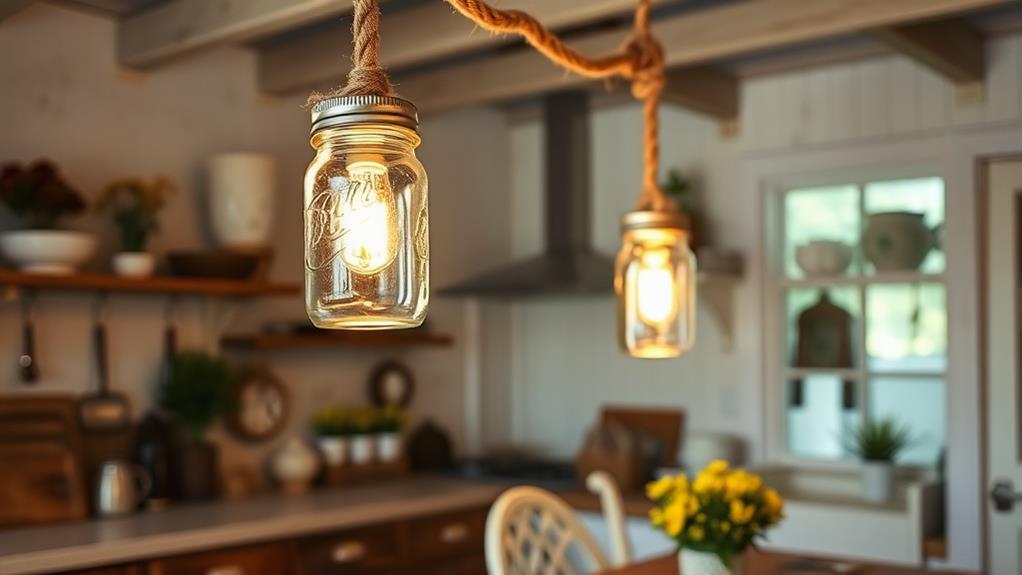
Transforming everyday objects into unique lighting fixtures not only adds character to your home but also promotes sustainability. Mason jars, a popular choice for DIY enthusiasts, can be easily converted into charming pendant lights or table lamps with the addition of electrical components and decorative elements.
Wine bottles, when carefully cut and sanded, make elegant bases for table lamps or can be strung with fairy lights for a whimsical effect.
Vintage kitchen utensils, such as colanders or cheese graters, can be repurposed into quirky ceiling lights that cast interesting shadows. Old books can be stacked and hollowed out to create a base for table lamps, adding a literary touch to any room. Bicycle wheels, when suspended from the ceiling and fitted with bulbs, transform into unique chandeliers that make a bold statement.
For outdoor lighting, consider upcycling tin cans into lanterns by punching decorative patterns into their sides. Teacups and saucers can be cleverly arranged to form delicate pendant lights, perfect for a shabby chic or vintage-inspired interior. These creative lighting solutions not only reduce waste but also infuse your space with personality and originality.
Repurposed Kitchen Utensils
Kitchen utensils often possess untapped potential for creative home decor. These everyday items can be transformed into unique and eye-catching pieces that add character to any room.
Vintage colanders, for instance, can be repurposed as pendant lights or planters, bringing a touch of rustic charm to kitchens or outdoor spaces. Large serving spoons and forks can be bent and mounted on walls as quirky coat hooks or jewelry organizers.
Old cookie cutters offer versatile decorating options, serving as festive wreaths when arranged in circular patterns or as whimsical wall art when painted and grouped together. Wooden cutting boards can be repurposed as serving trays or mounted on walls as display pieces for family photos and artwork.
Cheese graters can be transformed into industrial-style lighting fixtures or used as organizers for office supplies. Even simple utensils like spatulas and whisks can be arranged in decorative patterns and framed as kitchen-themed wall art. By thinking creatively, these once-mundane kitchen tools can become conversation starters and unique design elements that reflect personal style while reducing waste and promoting sustainability in home decor.
Book-Based Decor
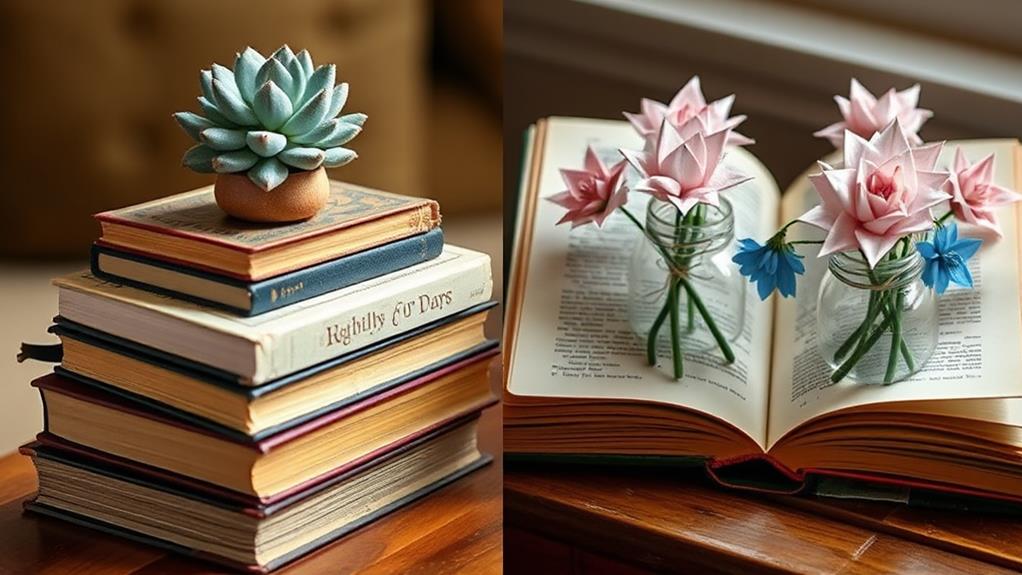
Books can easily double as captivating decor elements, adding character and intellectual charm to any living space. Beyond their primary function as reading material, books offer versatile options for enhancing interior design.
Create a striking focal point by arranging colorful book spines on floating shelves, forming a vibrant backdrop for any room. Alternatively, stack books horizontally to serve as unique pedestals for plants, picture frames, or decorative objects.
For a more artistic approach, consider crafting book page wreaths or folded book sculptures. These intricate creations transform old books into eye-catching wall art or table centerpieces. Vintage hardcovers can be repurposed as unconventional storage solutions by hollowing out their interiors to conceal small items.
Large, oversized art books make excellent coffee table displays, inviting guests to peruse their contents while adding visual interest to the space. For a minimalist look, turn books spine-inward on shelves, creating a uniform, textured appearance. This technique works particularly well in neutral-toned rooms.
Pallet Projects
Wooden pallets offer a treasure trove of possibilities for DIY home decor enthusiasts. These versatile structures can be transformed into various functional and aesthetically pleasing pieces for your living space. One popular project is creating a rustic coffee table by sanding down a pallet, adding casters for mobility, and applying a protective finish.
For outdoor spaces, pallets can be repurposed into vertical gardens, providing an ideal solution for small balconies or patios.
Pallet wood can also be disassembled and used to create unique wall art, shelving units, or even a headboard for your bedroom. For those seeking storage solutions, pallet shoe racks or wine racks offer practical and stylish options.
More ambitious DIYers might tackle larger projects like constructing a pallet sofa or daybed, complete with cushions for added comfort.
When working with pallets, it's crucial to select those free from chemical treatments and to thoroughly clean and sand them before use. With proper preparation and creativity, pallet projects can add a touch of industrial chic or farmhouse charm to any home decor scheme, all while being eco-friendly and budget-conscious.
Frequently Asked Questions
How Do I Safely Clean and Sanitize Items Before Repurposing Them?
To safely clean and sanitize items before repurposing, start by wiping with warm, soapy water. For tougher grime, use a mixture of vinegar and water. Disinfect with diluted bleach or rubbing alcohol. Always rinse thoroughly and allow items to dry completely.
Are There Any Legal Restrictions on Repurposing Certain Items for Home Decor?
Ironically, in a world obsessed with rules, repurposing items for decor faces few legal restrictions. However, it's wise to consider safety regulations, copyright issues, and local ordinances. Always ensure repurposed items don't pose hazards in their new roles.
What Tools Are Essential for Beginners Starting DIY Repurposing Projects?
For beginners starting DIY repurposing projects, essential tools include a hammer, screwdriver set, measuring tape, pliers, safety goggles, and a utility knife. A power drill, sandpaper, paintbrushes, and a glue gun are also valuable additions to your toolkit.
How Can I Incorporate Repurposed Items Without Making My Home Look Cluttered?
To incorporate repurposed items without cluttering your home, focus on curating a cohesive aesthetic. Choose pieces that complement your existing decor, prioritize functionality, and maintain a balance between repurposed and new items. Embrace minimalism and strategic placement for a polished look.
Where Can I Find Inspiration for Unique Repurposing Ideas Not Covered in Guides?
Curious minds seek hidden gems of inspiration. Beyond conventional guides, explore social media platforms like Pinterest and Instagram, browse upcycling blogs, visit local flea markets, and join online DIY communities. These treasure troves often reveal unique, unexpected repurposing ideas.
Conclusion
Repurposing everyday items for home decor offers a sustainable and budget-friendly approach to interior design. This trend aligns with the growing interest in eco-conscious living, as evidenced by a 2022 study which found that 78% of consumers consider sustainability important when making home decor purchases. By transforming common objects into unique decorative pieces, individuals can reduce waste, express creativity, and cultivate a personalized living space. The versatility of repurposed items ensures endless possibilities for innovative and stylish home improvements.
